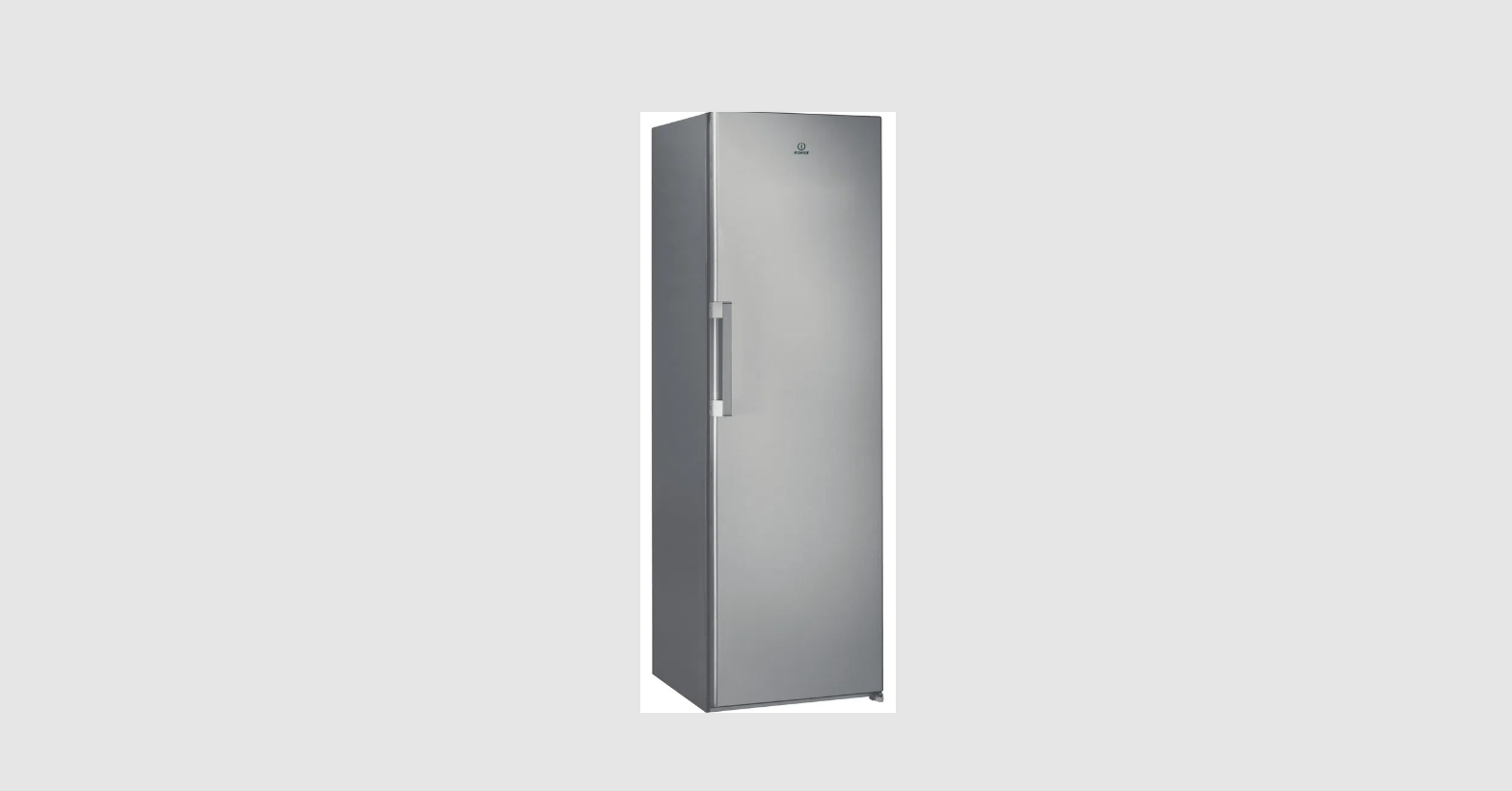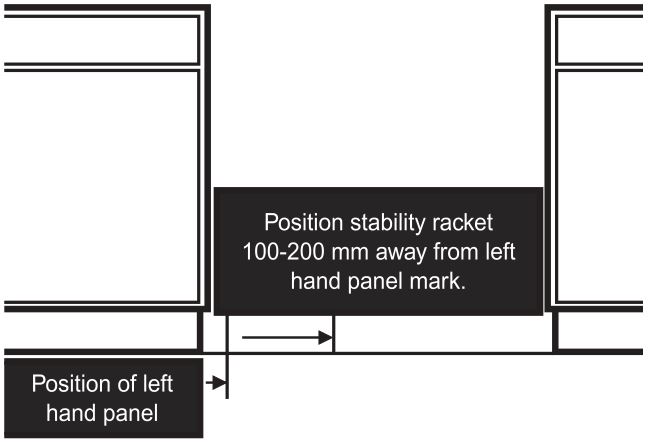INDESIT Fridge
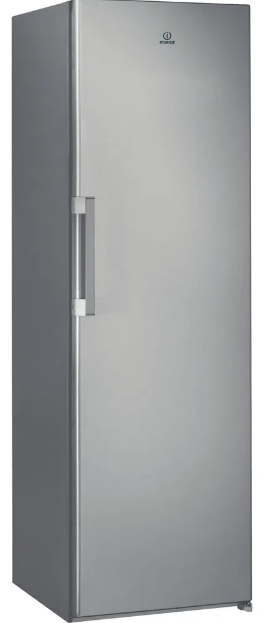
INDESIT Fridge
SIAA 10 xx (UK)SIAA 12 xx (UK)
Assistance
Guarantee
12 months Parts and Labour GuaranteeYour appliance has the benefit of our manufacturer’s guarantee, which covers the cost of breakdown repairs for twelve months from the date of purchase.
This gives you the reassurance that if, within that time, your appliance is proven to be defective because of either workmanship or materials, we will, at our discretion, either repair or replace the appliance at no cost to you.
This guarantee is subject to the following conditions:
- The appliance has been installed and operated correctly and in accordance with our operating and maintenance instructions.
- The appliance is used only on the electricity or gas supply printed on the rating plate.
- The appliance has been used for normal domestic purposes only.
- The appliance has not been altered, serviced, maintained, dismantled, or otherwise interfered with by any person not authorised by us.
- Any repair work must be under taken by us or our appointed agent.
- Any parts removed during repair work or any appliance that is replaced become our property.
- The appliance is used in the United Kingdom or Republic of Ireland.
The guarantee does not cover:
- Damage resulting from transportation, improper use, neglect or interference or as a result of improper installation.
- Replacement of any consumable item or accessory. These included but not limited to: plugs, cables, batteries, light bulbs, fluorescent tubes and starters, covers and filters.
- Replacement of any removable parts made of glass or plastic.
THIS GUARANTEE WILL NOT APPLY IF THE APPLIANCE HAS BEEN USED IN COMMERCIAL OR NON-DOMESTIC PREMISES.
5 Year Parts GuaranteeIndesit also offers you a free 5 year parts guarantee. This additional guarantee is conditional on you registering your appliance with us and the parts being fitted by one of our authorised engineers. There will be a charge for our engineer’s time. To activate the extra parts warranty on your appliance, simply call our registration line on 08448 24 24 24 (Republic of Ireland 01 230 0233).
Extended GuaranteesWe offer a selection of protection plans that enable you to fully cover yourself against the expense of repair bills for the life of your policy. To find the ideal plan for you please call our advice line on 08448 226 226 (Republic of Ireland 01 230 0233).
Helpdesk ServiceWe have a dedicated team who can provide free advice and assistance with your appliance if you experience any technical difficulties within the first 90 days of ownership. Simply call our Indesit Service Hotline on 08448 224 224 (Republic of Ireland 0818 313 413) for telephone assistance, or, where necessary, to arrange for an engineer to call.
After Sales ServiceNo one is better placed to care for your Indesit appliance during the course of its working life than us the manufacturer.
Indesit ServiceWe are the largest service team in the UK and Ireland offering you access to 400 skilled telephone advisors and 1000 fully qualified engineers on call to ensure you receive fast, reliable, local service.
UK: 08448 224 224Republic of Ireland: 0818 313 413www.indesitservice.co.uk
Please note: Our advisors will require the following information:Model number: _____________________________________Serial number: _____________________________________
Parts and AccessoriesWe supply a full range of genuine replacement parts as well as accessory products that protect and hygienically clean your appliance to keep it looking good and functioning efficiently throughout its life.
UK: 08448 225 225Republic of Ireland: 0818 313 413www.indesitservice.co.uk
Appliance RegistrationWe want to give you additional benefits of Indesit ownership. To activate your free 5 year parts guarantee you must register your appliance with us.
UK: 08448 24 24 24Republic of Ireland: 01 230 0233www.indesitservice.co.uk
Indesit Company UK Ltd. Morley Way, Peterborough, PE2 9JBIndesit Company Unit 49 Airways Industrial Estate, Dublin 17
Recycling and Disposal InformationAs part of Indesit’s continued commitment to helping the environment, Indesit reserves the right to use quality, recycled components to keep down customer costs and minimise material wastage.
Please dispose of packaging and old appliances carefully. To minimise the risk of injury to children, remove the door, plug, and cut the mains cable off flush with the appliance. Dispose of these parts separately to ensure that the appliance can no longer be plugged into mains socket, and the door cannot be locked shut.
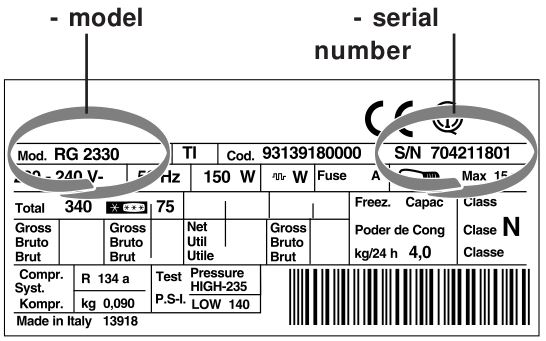
PLEASE PHONE US TO REGISTER YOUR APPLIANCE ANDACTIVATE YOUR 5 YEAR PARTS GUARANTEE ON 08448 24 24 24
Description of the appliance
Overall view
The instructions contained in this manual are applicable to different model refrigerators. The diagrams may not directly represent the appliance purchased. For more complex features, consult the following pages.
- Levelling FEET
- FRUIT and VEGETABLE bin.
- SHELVES*.
- LAMP (see Maintenance).
- TEMPERATURE control
- Removable multipurpose SHELVES*
- BOTTLE shelf
* Varies by number and/or position, available only on certain models.
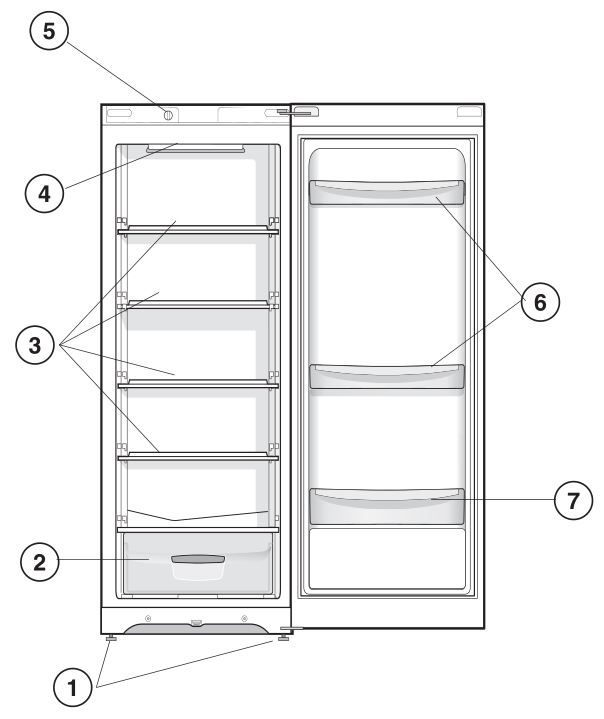
Reversible doors
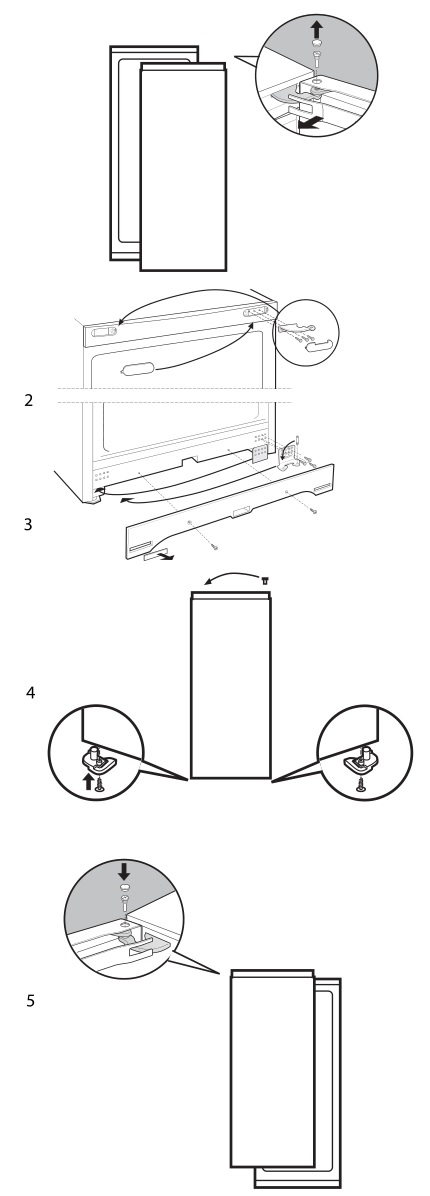
Installation
! Before placing your new appliance into operation please read these operating instructions carefully. They contain important information for safe use, for installation and for care of the appliance.
! Please keep these operating instructions for future reference. Pass them on to possible new owners of the appliance.
Positioning and connection
Positioning
- Place the appliance in a well-ventilated humidity-free room.
- Do not obstruct the rear fan grills. The compressor and condenser give off heat and require good ventilation to operate correctly and save energy.
- Leave a space of at least 10 cm between the top part of the appliance and any furniture above it, and at least 5 cm between the sides and any furniture/side walls.
- Ensure the appliance is away from any sources of heat (direct sunlight, electric stove, etc.).
- In order to maintain the correct distance between the appliance and the wall behind it, fit the spacers supplied in the installation kit, following the instructions provided.
Levelling
- Install the appliance on a level and rigid floor.
- If the floor is not perfectly horizontal, adjust the refrigerator by tightening or loosening the front feet.
Electrical connections
After the appliance has been transported, carefully place it vertically and wait at least 3 hours before connecting it to the electricity mains. Before inserting the plug into the electrical socket ensure the following:
- The appliance is earthed and the plug is compliant with the law.
- The socket can withstand the maximum power of the appliance, which is indicated on the data plate located on the bottom left side of the fridge (e.g. 150 W).
- The voltage must be in the range between the values indicated on the data plate located on the bottom left side (e.g. 220-240V).
- The socket is compatible with the plug of the appliance. If the socket is incompatible with the plug, ask an authorised technician to replace it ( see Assistance ). Do not use extension cords or multiple sockets.
! Once the appliance has been installed, the power supply cable and the electrical socket must be easily accessible.! The cable must not be bent or compressed.! The cable must be checked regularly and replaced by authorised technicians only (see Assistance).! The manufacturer declines any liability should these safety measures not be observed.
Stability bracket
WARNING: To prevent the fridge from tilting forwards, it must be held in place with the stability bracket supplied. This is the responsibility of the customer.
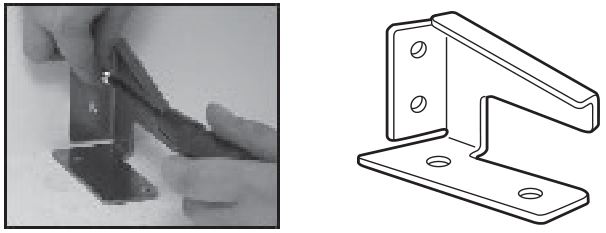
Fixed to the floor or wall at the rear of the fridge, the stability bracket hooks onto the compressor mounting plate holding the fridge secure.
* Varies by number and/or position, available only on certain models.
The stability bracket must be installed securely in accordance with these instructions BEFORE using the fridge.
Note: The fridge is heavy so care must be taken when moving it.
- Position the fridge in its chosen location.
- Looking from the front of the fridge, mark the position of the left hand panel.
- Move the fridge far enough away to get clear access to the back wall.
- In order to clear components on the compressor mounting plate, the stability bracket must be positioned on the floor between 100 – 200mm to the right of the left hand panel mark.
- Mark and drill the fixing holes and insert suitable fixings to hold the bracket firm.
- Carefully re-position the fridge. Make sure that the compressor mounting plate locates into the stability bracket.

Start-up and use
Starting the appliance
! Before starting the appliance, follow the installation instructions ( see Installation )
! Before connecting the appliance, clean the compartments and accessories well with lukewarm water and bicarbonate.
- Insert the plug into the socket and ensure that the internal light illuminates.
- Turn the TEMPERATURE ADJUSTMENT knob to an average value. After a few hours you will be able to put food in the refrigerator.
Setting the temperature
The temperature inside the refrigerator compartment automatically adjusts itself according to the position of the thermostat knob.
![]()
We recommend, however, a medium position.The cooling section of the refrigerator is located inside the back wall of the refrigerator compartment for increased space and improved aesthetics. During operation, the back wall will be covered in frost or water droplets depending on whether the compressor is operating or paused. Do not worry, the refrigerator is functioning normally. If the REFRIGERATOR OPERATION knob has been set on high values with large quantities of food and with a high ambient temperature, the appliance can operate continuously, resulting in excessive frost formation and excessive energy consumption: compensate for this by shifting the knob towards lower values (defrosting will occur automatically). In static appliances, the air circulates in a natural way: the colder air tends to move downwards as it is heavier. The food should be stored as follows:
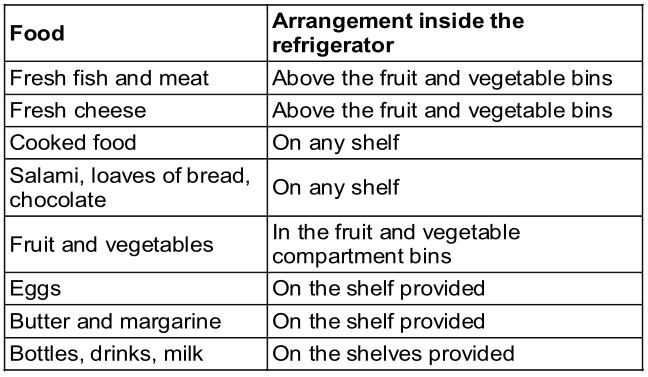
SHELVES * : with or without grill.Due to the special guides the shelves are removable and the height is adjustable ( see diagram ), allowing easy storage of large containers and food. Height can be adjusted without complete removal of the shelf.
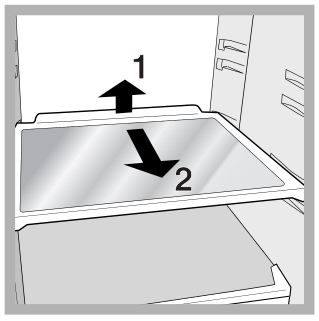
Using the refrigerator to its full potential
- Use the TEMPERATURE ADJUSTMENT knob to adjust the temperature ( see Description ).
- Place only cold or lukewarm foods in the compartment, not hot foods ( see Precautions and tips ).
- Remember that cooked foods do not last longer than raw foods.
- Do not store liquids in open containers. They will increase humidity in the refrigerator and cause condensation to form.
Maintenance and care
Switching the appliance off
During cleaning and maintenance it is necessary to disconnect the appliance from the electricity supply.It is not sufficient to set the temperature adjustment knobs on (appliance off) to eliminate all electrical contact.
Cleaning the appliance
- The external and internal parts, as well as the rubber seals may be cleaned using a sponge that has been soaked in lukewarm water and bicarbonate of soda or neutral soap. Do not use solvents, abrasive products, bleach or ammonia.
- The removable accessories may be soaked in warm water and soap or dishwashing liquid. Rinse and dry them carefully.
- The back of the appliance may collect dust which can be removed by delicately using the hose of a vacuum cleaner set on medium power. The appliance must be switched off and the plug must be pulled out before cleaning the appliance.
Avoiding mould and unpleasant odours
- The appliance is manufactured with hygienic materials which are odour free. In order to maintain an odour free refrigerator and to prevent the formation of stains, food must always be covered or sealed properly.
- If you want to switch the appliance off for an extended period of time, clean the inside and leave the doors open.
Defrosting the appliance
! Follow the instructions below.
Do not speed up the defrosting process by using any devices or tools other than the scraper provided, you may damage the refrigeration circuit.
The refrigerator has an automatic defrosting function: water is ducted to the back of the appliance by a special discharge outlet ( see diagram ) where the heat produced by the compressor causes it to evaporate. It is necessary to clean the discharge hole regularly so that the water can flow out easily.

Replacing the light bulb
To replace the light bulb in the refrigerator compartment, pull out the plug from the electrical socket. Follow the instructions below. Access the light bulb by removing the cover as indicated in the diagram. Replace it with a similar light bulb within the power range indicated on the cover (15W or 25W).

Precautions and tips
! The appliance was designed and manufactured in compliance with international safety standards. The following warnings are provided for safety reasons and must be read carefully.
This appliance complies with the following Community Directives:– 73/23/EEC of 19/02/73 (Low Voltage) and subsequent amendments;-89/336/EEC of 03.05.89 (Electromagnetic Compatibility) and subsequent amendments;– 2002/96/CE..
![]()
General safety
- The appliance was designed for domestic use inside the home and is not intended for commercial or industrial use.
- The appliance must be used to store and freeze food products by adults only and according to the instructions in this manual.
- The appliance must not be installed outdoors, even in covered areas. It is extremely dangerous to leave the appliance exposed to rain and storms.
- Do not touch the appliance with bare feet or with wet or moist hands and feet.
- Do not touch the internal cooling elements: this could cause skin abrasions or frost/freezer burns.
- When unplugging the appliance always pull the plug from the mains socket, do not pull on the cable.
- Before cleaning and maintenance, always switch off the appliance and disconnect it from the electrical supply. It is not sufficient to set the temperature adjustment knobs on (appliance off) to eliminate all electrical contact.
- In the case of a malfunction, under no circumstances should you attempt to repair the appliance yourself. Repairs carried out by inexperienced persons may cause injury or further malfunctioning of the appliance.
- Do not use any sharp or pointed utensils or electrical equipment – other than the type recommended by the manufacturer – inside the frozen food storage compartments.
- Do not put ice cubes taken directly from the freezer into your mouth.
- This appliance is not intended for use by persons (including children) with reduced physical, sensory or lack of experience and knowledge unless they have been given supervision or instruction concerning use of the appliance by a person responsible for their safety. Children should be supervised to ensure that they do not play with the appliance.
- Keep packaging material out of the reach of children! It can become a choking or suffocation hazard.
Disposal
- Observe local environmental standards when disposing packaging material for recycling purposes.
- The European Directive 2002/96/EC on Waste Electrical and Electronic Equipment (WEEE), requires that old householdelectrical appliances must not be disposed of in the normal unsorted municipal waste stream. Old appliances must be collected separately in order to optimise the recovery and recycling of the materials they contain and reduce the impact on human health and the environment. The crossed out “wheeled bin” symbol on the product reminds you of your obligation, that when you dispose of the appliance it must be separately collected. Consumers should contact their local authority or retailer for information concerning the correct disposal of their old appliance.
Respecting and conserving the environment
- Install the appliance in a fresh and well-ventilated room. Ensure that it is protected from direct sunlight and do not place it near heat sources.
- Try to avoid keeping the door open for long periods or opening the door too frequently in order to conserve energy.
- Do not fill the appliance with too much food: cold air must circulate freely for food to be preserved properly. If circulation is impeded, the compressor will work continuously.
- Do not place hot food directly into the refrigerator. The internal temperature will increase and force the compressor to work harder and will consume more energy.
- Defrost the appliance if ice forms ( see Maintenance ). A thick layer of ice makes cold transference to food products more difficult and results in increased energy consumption.
- Regularly check the door seals and wipe clean to ensure they are free of debris and to prevent cold air from escaping ( see Maintenance ).
Troubleshooting
If the appliance does not work, before calling for Assistance (see Assistance), check for a solution from the following list.
The internal light does not illuminate.
- The plug has not been inserted into the electrical socket, or not far enough to make contact, or there is no power in the house.
- The TEMPERATURE CONTROL Knob is on setting.
The refrigerator do not cool well.
- The door do not close properly or the seals are damaged.
- The door are opened too frequently.
- The TEMPERATURE ADJUSTMENT knob is not in the correct position
- The refrigerator have been over-filled.
The food inside the refrigerator is beginning to freeze.
- The TEMPERATURE ADJUSTMENT knob is not in the correct position.
- The food is in contact with the back inside wall of the refrigerator.
The motor runs continuously.
- The door is not closed properly or is continuously opened.
- The outside ambient temperature is very high.
The appliance makes a lot of noise.
- The appliance has not been installed on a level surface ( see Installation ) .
- The appliance has been installed between cabinets that vibrate and make noise.
- The internal refrigerant makes a slight noise even when the compressor is off. This is not a defect, it is normal.
The back wall of the refrigerator unit is covered in frost or droplets of water
- This shows the appliance is operating normally.
There is water at the bottom of the refrigerator.
- The water discharge hole is blocked ( see Maintenance ).
FAQ’S
Please contact the customer service department of the company you purchased the refrigerator from. They will be able to help you.
The serial number is located on the rating plate, which is located on the back of your refrigerator.
You can check the rating plate on the back of your refrigerator. If it has a “W” next to the serial number, then it is still under warranty. If it does not have a “W”, then your warranty has expired.
Pull the unit away from the wall and unplug it. Check the owner’s manual for any “off” or “zero” settings in your fridge and freezer and set them to off or zero. Plug the unit back in and adjust the temperature controls of both to your desired setting. Give the fridge about 24 hours to cool to your set temperature.
Refrigerator Is Too FullIf there are too many items in your fresh food compartment, that cold air may not circulate properly, resulting in a refrigerator that’s warm. It’s fairly common for a refrigerator to feel warm if it’s overstuffed, and this problem is obviously easy to resolve.
Your refrigerator compressor is responsible for that humming sound. So, if the sound stops for good, or if the sound goes from faint to a constant or very loud humming noise that does not shut off, it may be a sign the compressor is broken or malfunctioning.
Too Little or Too Much RefrigerantIn the event that the amount of refrigerant in the system is not perfect, it could create too much pressure or strain and lead to compressor failure. Too little refrigerant is most likely caused by an insufficient charge from the last technician, or from a refrigerant leak.
Refrigerator Damage Caused by a Lack of MaintenanceThe three most common reasons for failures that we see as a result of wear & tear are a mechanically locked compressor, failure of the fan motor, and dirty condenser coils.
The first thing to check is the breaker (in your home’s electrical service panel) of the circuit serving the fridge. Most homes have a dedicated 20-amp circuit for the fridge alone, while older homes may have it on a general kitchen circuit.
Running a fridge-freezer costs around seven per cent of your total energy bill, because it’s one of the few appliances that you have to keep on the whole time. But there are a few tricks that you can try to shave off a bit off the cost.
1 YEARIndesit care plansOur appliances come with a 1 year manufacturers guarantee just by simply registering your appliance. Get extra protection with a Repair & Care plan, which offers an initial repair and ongoing care for one or more home appliances.
If the doors of the refrigerator are opened frequently or if they are not sealed properly, the warmer air outside will get into the appliance. This condensation then turns into moisture or frost. To avoid this, try not to open the door too often, or leave it open for too long.
VIDEO
References
[xyz-ips snippet=”download-snippet”]

